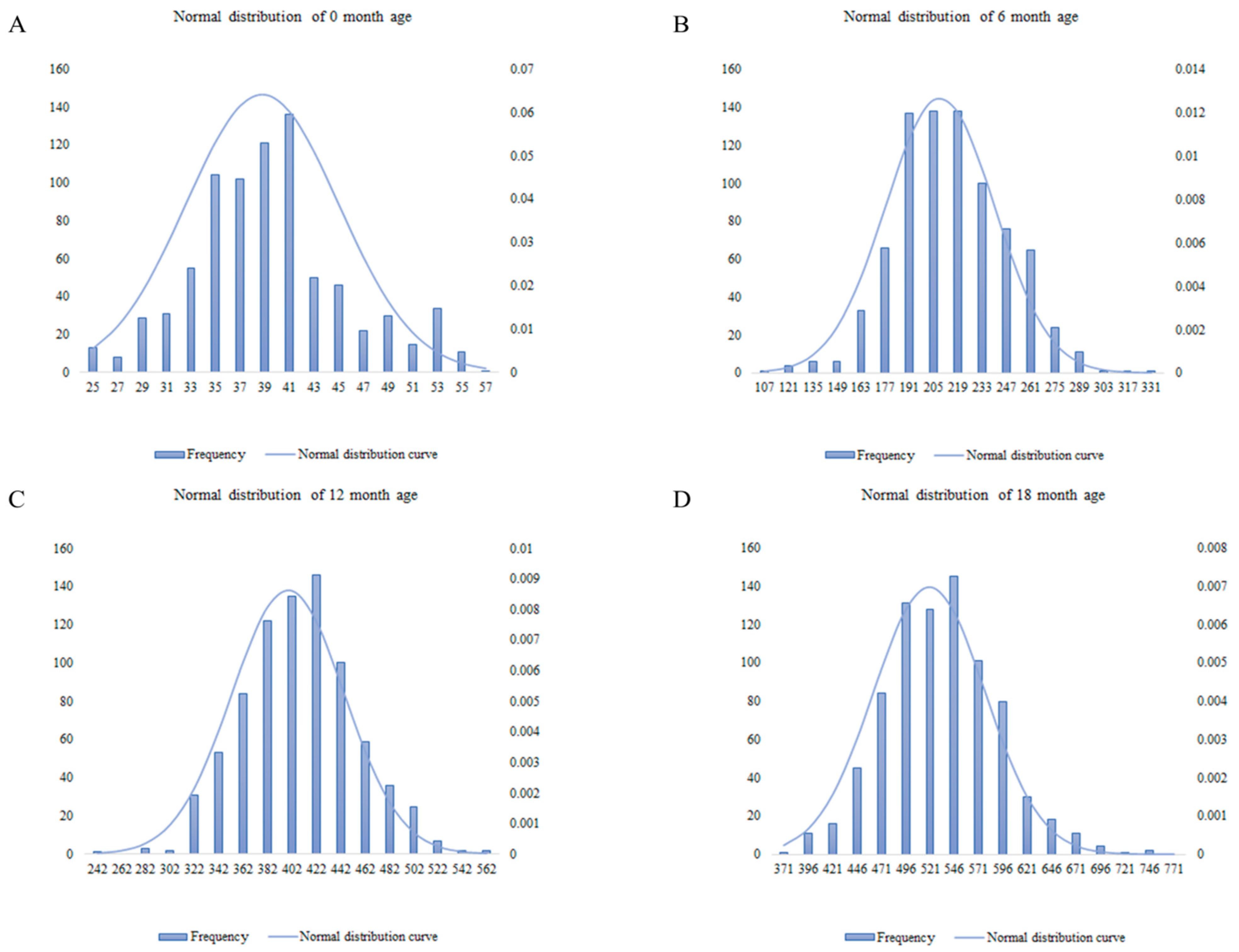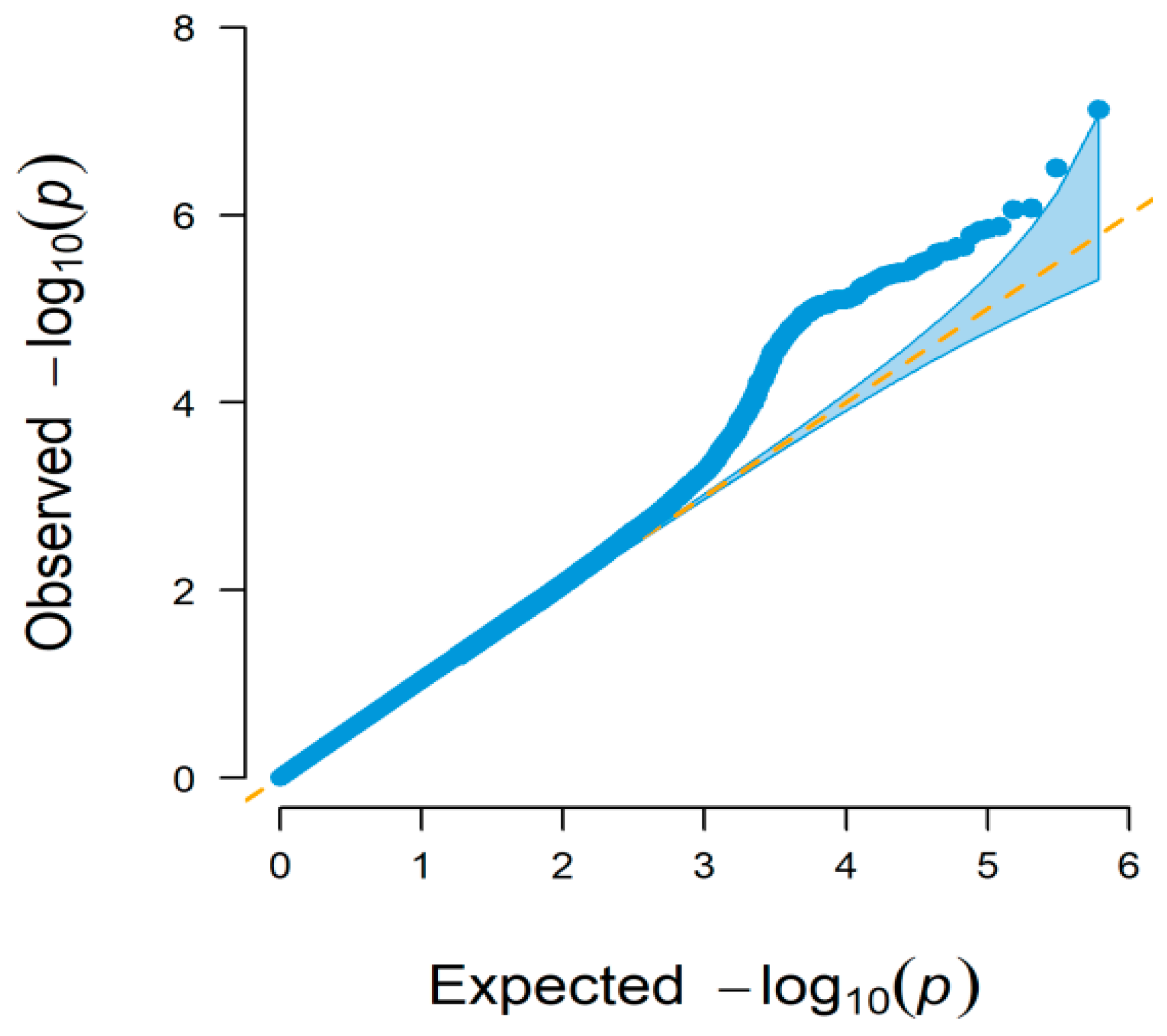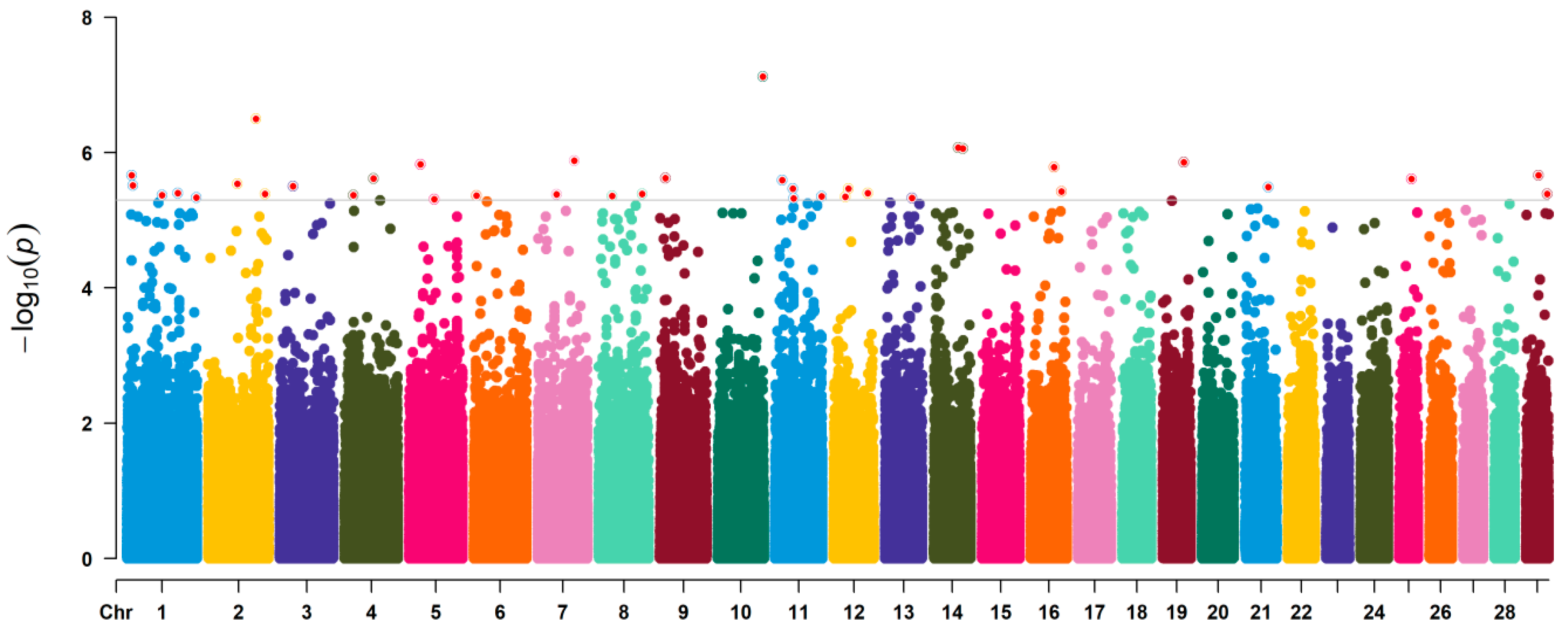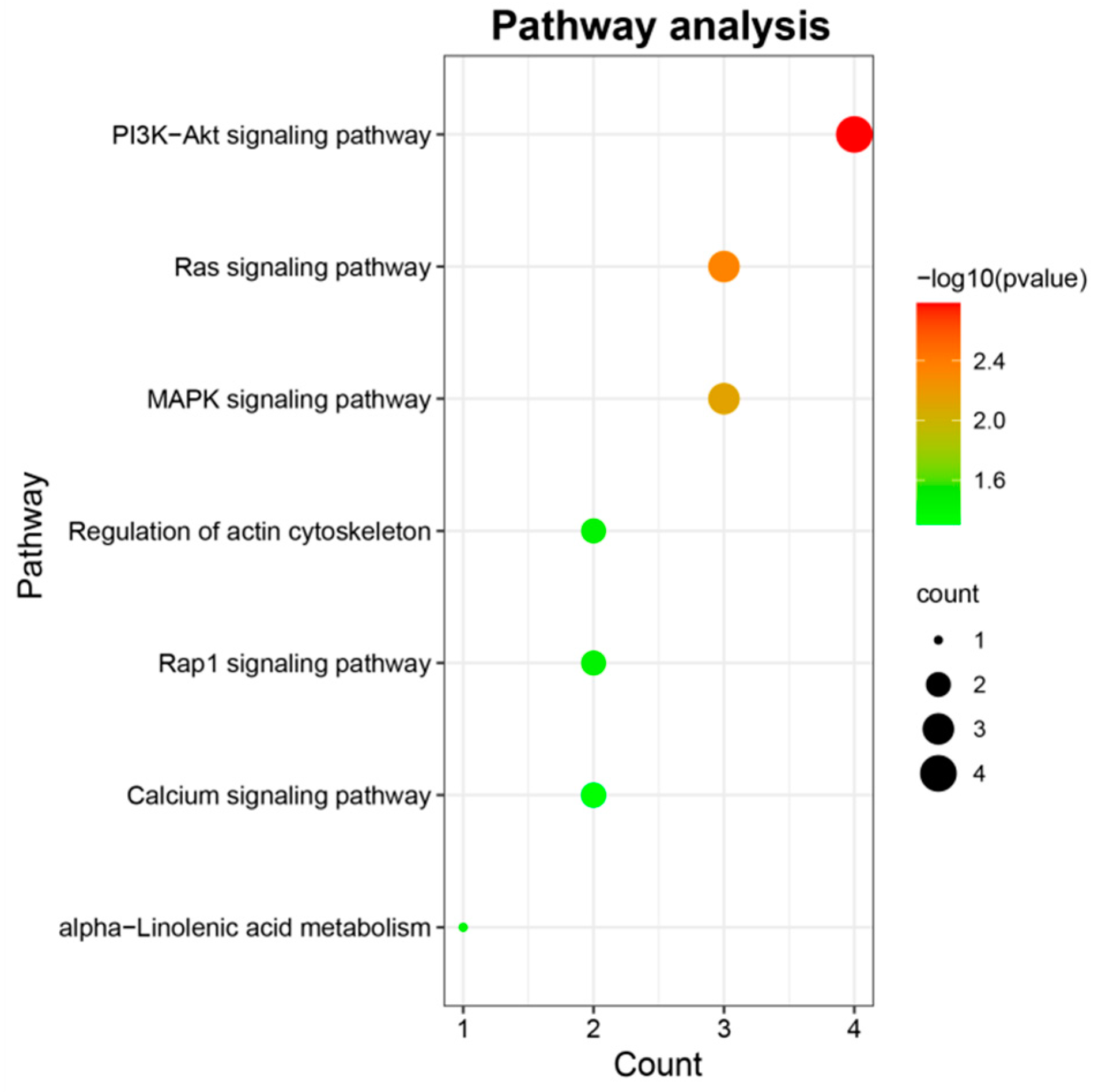Genome-Wide Association Study Based on Random Regression Model Reveals Candidate Genes Associated with Longitudinal Data in Chinese Simmental Beef Cattle
Abstract
Simple Summary
Abstract
1. Introduction
2. Materials and Methods
2.1. Animal Resource and Phenotypes Recording
2.2. Genotyping and Quality Control
2.3. Population Stratification
2.4. Genome-Wide Association Study Based on the Random Regression Model
2.5. Detection and Functional Enrichment of Candidate Gene
2.6. Statistical Analysis
3. Results
3.1. Data Statistics of Body Weight
3.2. Genome-Wide Association Study Based on the Random Regression Model
3.3. Genes Detection
3.4. Functional Annotation of Candidate Genes
4. Discussion
5. Conclusions
Supplementary Materials
Author Contributions
Funding
Institutional Review Board Statement
Informed Consent Statement
Data Availability Statement
Acknowledgments
Conflicts of Interest
References
- Groenen, M.A.; Archibald, A.L.; Uenishi, H.; Tuggle, C.K.; Takeuchi, Y.; Rothschild, M.F.; Rogel-Gaillard, C.; Park, C.; Milan, D.; Megens, H.J.; et al. Analyses of pig genomes provide insight into porcine demography and evolution. Nature 2012, 491, 393–398. [Google Scholar] [CrossRef] [PubMed]
- Zimin, A.V.; Delcher, A.L.; Florea, L.; Kelley, D.R.; Schatz, M.C.; Puiu, D.; Hanrahan, F.; Pertea, G.; Van Tassell, C.P.; Sonstegard, T.S.; et al. A whole-genome assembly of the domestic cow, Bos taurus. Genome Biol. 2009, 10, R42. [Google Scholar] [CrossRef] [PubMed]
- Jiang, Y.; Xie, M.; Chen, W.; Talbot, R.; Maddox, J.F.; Faraut, T.; Wu, C.; Muzny, D.M.; Li, Y.; Zhang, W.; et al. The sheep genome illuminates biology of the rumen and lipid metabolism. Science (N. Y.) 2014, 344, 1168–1173. [Google Scholar] [CrossRef] [PubMed]
- Sequence and comparative analysis of the chicken genome provide unique perspectives on vertebrate evolution. Nature 2004, 432, 695–716. [CrossRef] [PubMed]
- Lu, L.; Chen, Y.; Wang, Z.; Li, X.; Chen, W.; Tao, Z.; Shen, J.; Tian, Y.; Wang, D.; Li, G.; et al. The goose genome sequence leads to insights into the evolution of waterfowl and susceptibility to fatty liver. Genome Biol. 2015, 16, 89. [Google Scholar] [CrossRef]
- Huang, W.; Kirkpatrick, B.W.; Rosa, G.J.; Khatib, H. A genome-wide association study using selective DNA pooling identifies candidate markers for fertility in Holstein cattle. Anim. Genet. 2010, 41, 570–578. [Google Scholar] [CrossRef]
- Bedhane, M.; van der Werf, J.; Gondro, C.; Duijvesteijn, N.; Lim, D.; Park, B.; Park, M.N.; Hee, R.S.; Clark, S. Genome-Wide Association Study of Meat Quality Traits in Hanwoo Beef Cattle Using Imputed Whole-Genome Sequence Data. Front Genet. 2019, 10, 1235. [Google Scholar] [CrossRef]
- Martínez, R.; Bejarano, D.; Gómez, Y.; Dasoneville, R.; Jiménez, A.; Even, G.; Sölkner, J.; Mészáros, G. Genome-wide association study for birth, weaning and yearling weight in Colombian Brahman cattle. Genet. Mol. Biol. 2017, 40, 453–459. [Google Scholar] [CrossRef]
- Kim, J.J.; Farnir, F.; Savell, J.; Taylor, J.F. Detection of quantitative trait loci for growth and beef carcass fatness traits in a cross between Bos taurus (Angus) and Bos indicus (Brahman) cattle. J. Anim. Sci. 2003, 81, 1933–1942. [Google Scholar] [CrossRef]
- Buzanskas, M.E.; Grossi, D.A.; Ventura, R.V.; Schenkel, F.S.; Sargolzaei, M.; Meirelles, S.L.; Mokry, F.B.; Higa, R.H.; Mudadu, M.A.; da Silva, M.V.; et al. Genome-wide association for growth traits in Canchim beef cattle. PLoS ONE 2014, 9, e94802. [Google Scholar]
- Zhuang, Z.; Xu, L.; Yang, J.; Gao, H.; Zhang, L.; Gao, X.; Li, J.; Zhu, B. Weighted Single-Step Genome-Wide Association Study for Growth Traits in Chinese Simmental Beef Cattle. Genes 2020, 11, 189. [Google Scholar] [CrossRef] [PubMed]
- Xue, Q.; Zhang, G.; Li, T.; Ling, J.; Zhang, X.; Wang, J. Transcriptomic profile of leg muscle during early growth in chicken. PLoS ONE 2017, 12, e0173824. [Google Scholar] [CrossRef] [PubMed]
- Hu, Z.L.; Park, C.A.; Wu, X.L.; Reecy, J.M. Animal QTLdb: An improved database tool for livestock animal QTL/association data dissemination in the post-genome era. Nucleic Acids Res. 2013, 41, D871–D879. [Google Scholar] [CrossRef] [PubMed]
- Ning, C.; Wang, D.; Zheng, X.; Zhang, Q.; Zhang, S.; Mrode, R.; Liu, J.F. Eigen decomposition expedites longitudinal genome-wide association studies for milk production traits in Chinese Holstein. Genetics, selection. Evolution GSE 2018, 50, 12. [Google Scholar]
- Wang, D.; Ning, C.; Liu, J.F.; Zhang, Q.; Jiang, L. Short communication: Replication of genome-wide association studies for milk production traits in Chinese Holstein by an efficient rotated linear mixed model. Journal of dairy science. J. Dairy Sci. 2019, 102, 2378–2383. [Google Scholar] [CrossRef]
- Henderson, C.R., Jr. Analysis of covariance in the mixed model: Higher-level, nonhomogeneous, and random regressions. Biometrics 1982, 38, 623–640. [Google Scholar] [CrossRef] [PubMed]
- Schaeffer, L.R. Application of random regression models in animal breeding. Livestock Prod. Sci. 2004, 86, 35–45. [Google Scholar] [CrossRef]
- Ning, C.; Kang, H.; Zhou, L.; Wang, D.; Wang, H.; Wang, A.; Fu, J.; Zhang, S.; Liu, J. Performance Gains in Genome-Wide Association Studies for Longitudinal Traits via Modeling Time-varied effects. Sci. Rep. 2017, 7, 590. [Google Scholar] [CrossRef]
- Emamgholi Begli, H.; Vaez Torshizi, R.; Masoudi, A.A.; Ehsani, A.; Jensen, J. Genomic dissection and prediction of feed intake and residual feed intake traits using a longitudinal model in F2 chickens. Animal 2018, 12, 1792–1798. [Google Scholar] [CrossRef]
- Oliveira, H.R.; Lourenco, D.A.L.; Masuda, Y.; Misztal, I.; Tsuruta, S.; Jamrozik, J.; Brito, L.F.; Silva, F.F.; Cant, J.P.; Schenkel, F.S. Single-step genome-wide association for longitudinal traits of Canadian Ayrshire, Holstein, and Jersey dairy cattle. J. Dairy Sci. 2019, 102, 9995–10011. [Google Scholar] [CrossRef]
- Howard, J.T.; Jiao, S.; Tiezzi, F.; Huang, Y.; Gray, K.A.; Maltecca, C. Genome-wide association study on legendre random regression coefficients for the growth and feed intake trajectory on Duroc Boars. BMC Genet. 2015, 16, 59. [Google Scholar] [CrossRef][Green Version]
- Jamrozik, J.; Schaeffer, L.R. Estimates of genetic parameters for a test day model with random regressions for yield traits of first lactation Holsteins. J. Dairy Sci. 1997, 80, 762–770. [Google Scholar] [CrossRef]
- Oliveira, H.R.; Brito, L.F.; Lourenco, D.A.L.; Silva, F.F.; Jamrozik, J.; Schaeffer, L.R.; Schenkel, F.S. Invited review: Advances and applications of random regression models: From quantitative genetics to genomics. J. Dairy Sci. 2019, 102, 7664–7683. [Google Scholar] [CrossRef]
- Duan, X.; An, B.; Du, L.; Chang, T.; Liang, M.; Yang, B.G.; Xu, L.; Zhang, L.; Li, J.; E, G.; et al. Genome-Wide Association Analysis of Growth Curve Parameters in Chinese Simmental Beef Cattle. Animals 2021, 11, 192. [Google Scholar] [CrossRef]
- Purcell, S.; Neale, B.; Todd-Brown, K.; Thomas, L.; Ferreira, M.A.; Bender, D.; Maller, J.; Sklar, P.; de Bakker, P.I.; Daly, M.J.; et al. PLINK: A tool set for whole-genome association and population-based linkage analyses. Am. J. Hum. Genet. 2007, 81, 559–575. [Google Scholar] [CrossRef]
- Das, K.; Li, J.; Wang, Z.; Tong, C.; Fu, G.; Li, Y.; Xu, M.; Ahn, K.; Mauger, D.; Li, R.; et al. A dynamic model for genome-wide association studies. Hum. Genet. 2011, 129, 629–639. [Google Scholar] [CrossRef]
- Benjamini, Y.; Hochberg, Y. Controlling the False Discovery Rate: A Practical and Powerful Approach to Multiple Testing. J. R. Stat. Soc. Ser. B Methodol. 1995, 57, 289–300. [Google Scholar] [CrossRef]
- Athanasios, A.; Charalampos, V.; Vasileios, T.; Ashraf, G.M. Protein-Protein Interaction (PPI) Network: Recent Advances in Drug Discovery. Curr. Drug Metab. 2017, 18, 5–10. [Google Scholar] [CrossRef] [PubMed]
- Yu, G.; Wang, L.G.; Han, Y.; He, Q.Y. clusterProfiler: An R package for comparing biological themes among gene clusters. OMICS 2012, 16, 284–287. [Google Scholar] [CrossRef] [PubMed]
- Li, Z.; Sillanpää, M.J. Dynamic Quantitative Trait Locus Analysis of Plant Phenomic Data. Trends. Plant. Sci. 2015, 20, 822–833. [Google Scholar] [CrossRef] [PubMed]
- Bi, P.; Ramirez-Martinez, A.; Li, H.; Cannavino, J.; McAnally, J.R.; Shelton, J.M.; Sánchez-Ortiz, E.; Bassel-Duby, R.; Olson, E.N. Control of muscle formation by the fusogenic micropeptide myomixer. Science (N. Y.) 2017, 356, 323–327. [Google Scholar] [CrossRef]
- Yang, G.N.; Kopecki, Z.; Cowin, A.J. Role of Actin Cytoskeleton in the Regulation of Epithelial Cutaneous. Stem Cells Dev. 2016, 25, 749–759. [Google Scholar] [CrossRef] [PubMed]
- Ito, N.; Ruegg, U.T.; Takeda, S. ATP-Induced Increase in Intracellular Calcium Levels and Subsequent Activation of mTOR as Regulators of Skeletal Muscle Hypertrophy. Int. J. Mol. Sci. 2018, 19, 2804. [Google Scholar] [CrossRef]
- Itoh, N.; Ornitz, D.M. Evolution of the Fgf and Fgfr gene families. Trends Genet. TIG 2004, 20, 563–569. [Google Scholar] [CrossRef]
- Cotton, L.M.; O’Bryan, M.K.; Hinton, B.T. Cellular signaling by fibroblast growth factors (FGFs) and their receptors (FGFRs) in male reproduction. Endocr. Rev. 2008, 29, 193–216. [Google Scholar] [CrossRef] [PubMed]
- Sánchez-Sánchez, A.V.; Camp, E.; García-España, A.; Leal-Tassias, A.; Mullor, J.L. Medaka Oct4 is expressed during early embryo development, and in primordial germ cells and adult gonads. Dev. Dyn. 2010, 239, 672–679. [Google Scholar] [CrossRef]
- Ji, J.; Yan, G.; Chen, D.; Xiao, S.; Gao, J.; Zhang, Z. An association study using imputed whole-genome sequence data identifies novel significant loci for growth-related traits in a Duroc × Erhualian F(2) population. J. Anim. Breed. Genet. 2019, 136, 217–228. [Google Scholar] [CrossRef]
- Sato, S.; Takahashi, T.; Nishinomiya, H.; Katoh, M.; Itoh, R.; Yokoo, M.; Yokoo, M.; Iha, M.; Mori, Y.; Kasuga, K.; et al. Common nucleotide sequence of structural gene encoding fibroblast growth factor 4 in eight cattle derived from three breeds. Anim. Sci. J. 2012, 83, 260–262. [Google Scholar] [CrossRef] [PubMed]
- Yu, J.C.; DeSeabra, A.J.; Wang, L.M.; Fleming, T.P.; Chedid, M.; Miki, T.; Heidaran, M.A. An unexpected transforming gene in calf-thymus carrier DNA: Bovine hst. Gene 1995, 162, 333–334. [Google Scholar] [CrossRef]
- Feldman, B.; Poueymirou, W.; Papaioannou, V.E.; DeChiara, T.M.; Goldfarb, M. Requirement of FGF-4 for postimplantation mouse development. Science (N. Y.) 1995, 267, 246–249. [Google Scholar] [CrossRef]
- Desai, U.; Lee, E.C.; Chung, K.; Gao, C.; Gay, J.; Key, B.; Hansen, G.; Machajewski, D.; Platt, K.A.; Sands, A.T.; et al. Lipid-lowering effects of anti-angiopoietin-like 4 antibody recapitulate the lipid phenotype found in angiopoietin-like 4 knockout mice. Proc. Natl. Acad. Sci. USA 2007, 104, 11766–11771. [Google Scholar] [CrossRef]
- Mamedova, L.K.; Robbins, K.; Johnson, B.J.; Bradford, B.J. Tissue expression of angiopoietin-like protein 4 in cattle. J. Anim. Sci. 2010, 88, 124–130. [Google Scholar] [CrossRef] [PubMed]
- Kersten, S.; Mandard, S.; Tan, N.S.; Escher, P.; Metzger, D.; Chambon, P.; Gonzalez, F.J.; Desvergne, B.; Wahli, W. Characterization of the fasting-induced adipose factor FIAF, a novel peroxisome proliferator-activated receptor target gene. J. Biol. Chem. 2000, 275, 28488–28493. [Google Scholar] [CrossRef] [PubMed]
- Mandard, S.; Zandbergen, F.; van Straten, E.; Wahli, W.; Kuipers, F.; Müller, M.; Kersten, S. The fasting-induced adipose factor/angiopoietin-like protein 4 is physically associated with lipoproteins and governs plasma lipid levels and adiposity. J. Biol. Chem. 2006, 281, 934–944. [Google Scholar] [CrossRef] [PubMed]
- Bäckhed, F.; Ding, H.; Wang, T.; Hooper, L.V.; Koh, G.Y.; Nagy, A.; Semenkovich, C.F.; Gordon, J.I. The gut microbiota as an environmental factor that regulates fat storage. Proc. Natl. Acad. Sci. USA 2004, 101, 15718–15723. [Google Scholar] [CrossRef] [PubMed]
- Murakami, M.; Nakatani, Y.; Atsumi, G.I.; Inoue, K.; Kudo, I. Regulatory Functions of Phospholipase A2. Crit. Rev. Immunol. 2017, 37, 127–195. [Google Scholar] [CrossRef] [PubMed]
- Das, U.N.; Madhavi, N. Effect of polyunsaturated fatty acids on drug-sensitive and resistant tumor cells in vitro. Lipids Health Dis. 2011, 10, 159. [Google Scholar] [CrossRef]
- Tsuji, S.; Ohno, Y.; Nakamura, S.; Yamada, T.; Noda, Y.; Saio, M.; Iwama, T.; Shimazawa, M.; Hara, H. Temozolomide has anti-tumor effects through the phosphorylation of cPLA(2) on glioblastoma cells. Brain Res. 2019, 1723, 146396. [Google Scholar] [CrossRef]
- Gluck, N.; Schwob, O.; Krimsky, M.; Yedgar, S. Activation of cytosolic phospholipase A2 and fatty acid transacylase is essential but not sufficient for thrombin-induced smooth muscle cell proliferation. Am. J. Physiol. Cell Physiol. 2008, 294, C1597–C1603. [Google Scholar] [CrossRef]
- Hirabayashi, T.; Murayama, T.; Shimizu, T. Regulatory mechanism and physiological role of cytosolic phospholipase A2. Biol. Pharm. Bull. 2004, 27, 1168–1173. [Google Scholar] [CrossRef]
- Dragos-Wendrich, M.; Sternstein, I.; Brunsch, C.; Moser, G.; Bartenschlager, H.; Reiner, G.; Geldermann, H. Linkage and QTL mapping for Sus scrofa chromosome 14. J. Anim. Breed. Genet. 2003, 120, 111–118. [Google Scholar] [CrossRef]
- Cao, Y.; Song, X.; Shan, H.; Jiang, J.; Xiong, P.; Wu, J.; Shi, F.; Jiang, Y. Genome-Wide Association Study of Body Weights in Hu Sheep and Population Verification of Related Single-Nucleotide Polymorphisms. Front. Genet. 2020, 11, 588. [Google Scholar] [CrossRef]
- Tomczak, K.K.; Marinescu, V.D.; Ramoni, M.F.; Sanoudou, D.; Montanaro, F.; Han, M.; Kunkel, L.M.; Kohane, I.S.; Beggs, A.H. Expression profiling and identification of novel genes involved in myogenic differentiation. Faseb. J. Nlm. Id. 2004, 18, 403–405. [Google Scholar] [CrossRef]
- Liu, J.; DeYoung, S.M.; Zhang, M.; Zhang, M.; Cheng, A.; Saltiel, A.R. Changes in integrin expression during adipocyte differentiation. Cell Metab. 2005, 2, 165–177. [Google Scholar] [CrossRef]
- Mittal, A.; Pulina, M.; Hou, S.Y.; Astrof, S. Fibronectin and integrin alpha 5 play essential roles in the development of the cardiac neural crest. Mech. Develop. 2010, 127, 472–484. [Google Scholar] [CrossRef]
- Tani, N.; Higashiyama, S.; Kawaguchi, N.; Madarame, J.; Ota, I.; Ito, Y.; Ohoka, Y.; Shiosaka, S.; Takada, Y.; Matsuura, N. Expression level of integrin alpha 5 on tumour cells affects the rate of metastasis to the kidney. Br. J. Cancer 2003, 88, 327–333. [Google Scholar] [CrossRef][Green Version]
- Fan, Q.C.; Tian, H.; Wang, Y.; Liu, X.B. Integrin-α5 promoted the progression of oral squamous cell carcinoma and modulated PI3K/AKT signaling pathway. Arch. Oral. Biol. 2019, 101, 85–91. [Google Scholar] [CrossRef]
- Chen, Z.; Chen, C.Z.; Gong, W.R.; Li, J.P.; Xing, Y.Q. Integrin-alpha5 mediates epidermal growth factor-induced retinal pigment epithelial cell proliferation and migration. Pathobiology 2010, 77, 88–95. [Google Scholar] [CrossRef] [PubMed]
- Fang, Z.; Yao, W.; Fu, Y.; Wang, L.Y.; Li, Z.; Yang, Y.; Shi, Y.; Qiu, S.; Fan, J.; Zha, X. Increased integrin alpha5beta1 heterodimer formation and reduced c-Jun expression are involved in integrin beta1 overexpression-mediated cell growth arrest. J. Cell. Biochem. 2010, 109, 383–395. [Google Scholar] [PubMed]
- Larzabal, L.; de Aberasturi, A.L.; Redrado, M.; Rueda, P.; Rodriguez, M.J.; Bodegas, M.E.; Montuenga, L.M.; Calvo, A. TMPRSS4 regulates levels of integrin α5 in NSCLC through miR-205 activity to promote metastasis. Br. J. Cancer. 2014, 110, 764–774. [Google Scholar] [CrossRef] [PubMed]
- Zhao, X.; Wang, C.; Wang, Y.; Lin, H.; Wang, H.; Hu, H.; Wang, J. Comparative gene expression profiling of muscle reveals potential candidate genes affecting drip loss in pork. BMC Genet. 2019, 20, 89. [Google Scholar] [CrossRef]
- Popovic, D.; Dikic, I. TBC1D5 and the AP2 complex regulate ATG9 trafficking and initiation of autophagy. EMBO Rep. 2014, 15, 392–401. [Google Scholar] [CrossRef] [PubMed]
- Bärlocher, K.; Hutter, C.A.J.; Swart, A.L.; Steiner, B.; Welin, A.; Hohl, M.; Letourneur, F.; Seeger, M.A.; Hilbi, H. Structural insights into Legionella RidL-Vps29 retromer subunit interaction reveal displacement of the regulator TBC1D5. Nat. Commun. 2017, 8, 1543. [Google Scholar] [CrossRef]
- Zhang, L.; Liu, J.; Zhao, F.; Ren, H.; Xu, L.; Lu, J.; Zhang, S.; Zhang, X.; Wei, C.; Lu, G.; et al. Genome-wide association studies for growth and meat production traits in sheep. PLoS ONE 2013, 8, e66569. [Google Scholar] [CrossRef] [PubMed]
- Nagano, T.; Takehara, S.; Takahashi, M.; Aizawa, S.; Yamamoto, A. Shisa2 promotes the maturation of somitic precursors and transition to the segmental fate in Xenopus embryos. Development 2006, 133, 4643–4654. [Google Scholar] [CrossRef]
- Hedge, T.A.; Mason, I. Expression of Shisa2, a modulator of both Wnt and Fgf signaling, in the chick embryo. Int. J. Dev. Biol. 2008, 52, 81–85. [Google Scholar] [CrossRef] [PubMed]
- Liu, Z.; Wang, C.; Liu, X.; Kuang, S. Shisa2 regulates the fusion of muscle progenitors. Stem. Cell Res. 2018, 31, 31–41. [Google Scholar] [CrossRef]
- Zhu, Y.; Tsuchida, A.; Yamamoto, A.; Furukawa, K.; Tajima, O.; Tokuda, N.; Aizawa, S.; Urano, T.; Kadomatsu, K.; Furukawa, K. Expression and roles of a xenopus head-forming gene homologue in human cancer cell lines. Nagoya. J. Med. Sci. 2008, 70, 73–82. [Google Scholar] [PubMed]
- Hu, Z.; Cao, J.; Zhang, J.; Ge, L.; Zhang, H.; Liu, X. Skeletal Muscle Transcriptome Analysis of Hanzhong Ma Duck at Different Growth Stages Using RNA-Seq. Biomolecules 2021, 11, 315. [Google Scholar] [CrossRef] [PubMed]
- Miller, C.L.; Yan, C. Targeting cyclic nucleotide phosphodiesterase in the heart: Therapeutic implications. J. Cardiovasc. Transl. 2010, 3, 507–515. [Google Scholar] [CrossRef]
- Bender, A.T.; Beavo, J.A. Cyclic nucleotide phosphodiesterases: Molecular regulation to clinical use. Pharmacol. Rev. 2006, 58, 488–520. [Google Scholar] [CrossRef]
- Miller, C.L.; Oikawa, M.; Cai, Y.; Wojtovich, A.P.; Nagel, D.J.; Xu, X.; Xu, H.; Florio, V.; Rybalkin, S.D.; Beavo, J.A.; et al. Role of Ca2+/calmodulin-stimulated cyclic nucleotide phosphodiesterase 1 in mediating cardiomyocyte hypertrophy. Circ. Res. 2009, 105, 956–964. [Google Scholar] [CrossRef] [PubMed]
- Cai, Y.; Nagel, D.J.; Zhou, Q.; Cygnar, K.D.; Zhao, H.; Li, F.; Pi, X.; Knight, P.A.; Yan, C. Role of cAMP-phosphodiesterase 1C signaling in regulating growth factor receptor stability, vascular smooth muscle cell growth, migration, and neointimal hyperplasia. Circ. Res. 2015, 116, 1120–1132. [Google Scholar] [CrossRef] [PubMed]
- Rybalkin, S.D.; Bornfeldt, K.E.; Sonnenburg, W.K.; Rybalkina, I.G.; Kwak, K.S.; Hanson, K.; Krebs, E.G.; Beavo, J.A. Calmodulin-stimulated cyclic nucleotide phosphodiesterase (PDE1C) is induced in human arterial smooth muscle cells of the synthetic, proliferative phenotype. J. Clin. Invest. Nlm. 1997, 100, 2611–2621. [Google Scholar] [CrossRef] [PubMed]
- Tian, B.X.; Sun, W.; Wang, S.H.; Liu, P.J.; Wang, Y.C. Differential expression and clinical significance of COX6C in human diseases. Am. J. Transl. Res. 2021, 13, 1–10. [Google Scholar]
- Duggan, A.T.; Kocha, K.M.; Monk, C.T.; Bremer, K.; Moyes, C.D. Coordination of cytochrome c oxidase gene expression in the remodelling of skeletal muscle. J. Exp. Biol. 2011, 214, 1880–1887. [Google Scholar] [CrossRef]
- Little, A.G.; Kocha, K.M.; Lougheed, S.C.; Moyes, C.D. Evolution of the nuclear-encoded cytochrome oxidase subunits in vertebrates. Physiol. Genomics 2010, 42, 76–84. [Google Scholar] [CrossRef]
- Sasaki, K.; Ono, M.; Takabe, K.; Suzuki, A.; Kurihara, Y. Specific intron-dependent loading of DAZAP1 onto the cox6c transcript suppresses pre-mRNA splicing efficacy and induces cell growth retardation. Gene 2018, 657, 1–8. [Google Scholar] [CrossRef]





| BTA 1 | SNP | Position 2 (bp) | Distance 3 (bp) | Gene | p-Value 4 |
|---|---|---|---|---|---|
| 1 | BovineHD0100045595 | 156,093,740 | within | TBC1D5 | 4.60 × 10−6 |
| BovineHD0100003348 | 10,460,874 | 243,218 | MRPL39 | 2.17 × 10−6 | |
| BovineHD0100004041 | 13,081,890 | 1,709,537 | NCAM2 | 3.07 × 10−6 | |
| BovineHD0100046569 | 114,775,186 | 56,124 | YWHAH | 3.97 × 10−6 | |
| BovineHD0100022686 | 78,806,582 | 77,944 | TPRG1 | 4.23 × 10−6 | |
| 2 | BovineHD0200031068 | 107,968,173 | within | PTPRN | 3.17 × 10−7 |
| BovineHD0200018897 | 65,376,344 | 98,097 | / | 2.91 × 10−6 | |
| BovineHD0200037229 | 128,220,525 | within | LOC282685 | 4.06 × 10−6 | |
| 3 | BovineHD0300009402 | 29,779,589 | within | PHTF1 | 3.12 × 10−6 |
| 4 | Hapmap36353-SCAFFOLD29708_3468 | 64,923,141 | 62,596 | PDE1C | 2.41 × 10−6 |
| BovineHD0400005814 | 19,409,767 | 41,461 | THSD7A | 4.25 × 10−6 | |
| 5 | BovineHD0500007511 | 25,778,691 | within | ITGA5 | 1.48 × 10−6 |
| ARS-BFGL-NGS-119234 | 56,876,453 | 1314 | SDR9C7 | 4.86 × 10−6 | |
| 6 | BovineHD0600001415 | 6,027,009 | 7189 | BT.87489 | 4.30 × 10−6 |
| 7 | BovineHD0700024228 | 82,801,757 | within | RARS | 1.31 × 10−6 |
| BovineHD0700012290 | 42,156,049 | / | / | 4.15 × 10−6 | |
| 8 | BovineHD0800029069 | 98,418,906 | within | ZNF462 | 4.06 × 10−6 |
| BovineHD0800009085 | 29,939,592 | 90,148 | NFIB | 4.35 × 10−6 | |
| 9 | BovineHD0900003150 | 12,246,543 | 314,022 | RIMS1 | 2.38 × 10−6 |
| 10 | BovineHD1000029459 | 101,577,026 | within | TTC8 | 7.55 × 10−8 |
| 11 | BovineHD1100004962 | 15,555,441 | within | LTBP1 | 2.54 × 10−6 |
| BovineHD1100011885 | 40,440,551 | 109,804 | VRK2 | 3.42 × 10−6 | |
| BovineHD1100030552 | 105,125,657 | 15,309 | / | 4.45 × 10−6 | |
| BovineHD1100012203 | 41,709,686 | 965,290 | FANCL | 4.77 × 10−6 | |
| 12 | BovineHD1200027798 | 33,568,673 | 9620 | SHISA2 | 3.40 × 10−6 |
| BovineHD1200026844 | 26,501,234 | 386,041 | CHMP3 | 4.49 × 10−6 | |
| ARS-BFGL-NGS-37745 | 77,271,637 | within | TMTC4 | 4.40 × 10−6 | |
| 13 | BovineHD1300017420 | 60,743,532 | within | ANGPTL4 | 4.72 × 10−6 |
| 14 | BovineHD1400018666 | 66,735,095 | 95,093 | COX6C | 8.66 × 10−7 |
| BovineHD1400015595 | 55,998,180 | 654,428 | KCNV1 | 8.50 × 10−7 | |
| 16 | BovineHD1600019714 | 69,438,282 | 38,338 | PLA2G4A | 3.78 × 10−6 |
| ARS-BFGL-NGS-56551 | 52,584,126 | within | INTS11 | 1.65 × 10−6 | |
| 19 | BovineHD1900013251 | 47,547,492 | 11,129 | TLK2 | 1.39 × 10−6 |
| 21 | BovineHD2100021363 | 52,053,470 | 24,294 | LRFN5 | 3.23 × 10−6 |
| 25 | BovineHD2500007568 | 27,048,437 | 325 | FBRS | 2.45 × 10−6 |
| 29 | BovineHD2900014092 | 47,651,695 | 4899 | FGF4 | 4.09 × 10−6 |
| BovineHD2900008350 | 28,354,480 | 3970 | / | 2.16 × 10−6 |
| SNP | BTA 1 | Position 2 (bp) | Distance 3 (bp) | Gene | p-Value 4 |
|---|---|---|---|---|---|
| BovineHD2900014092 | 29 | 47,651,695 | 4,899 | FGF4 | 4.09 × 10−6 |
| BovineHD1300017420 | 13 | 60,743,532 | within | ANGPTL4 | 4.72 × 10−6 |
| BovineHD1600019714 | 16 | 69,438,282 | 38,338 | PLA2G4A | 3.78 × 10−6 |
| BovineHD0500007511 | 5 | 25,778,691 | within | ITGA5 | 1.48 × 10−6 |
| BovineHD0100045595 | 1 | 156,093,740 | within | TBC1D5 | 4.60 × 10−6 |
| BovineHD1200027798 | 12 | 33,568,673 | 9620 | SHISA2 | 3.40 × 10−6 |
| Hapmap36353-SCAFFOLD29708_3468 | 4 | 64,923,141 | 62,596 | PDE1C | 2.41 × 10−6 |
| BovineHD1400018666 | 14 | 66,735,095 | 95,093 | COX6C | 8.66 × 10−7 |
Publisher’s Note: MDPI stays neutral with regard to jurisdictional claims in published maps and institutional affiliations. |
© 2021 by the authors. Licensee MDPI, Basel, Switzerland. This article is an open access article distributed under the terms and conditions of the Creative Commons Attribution (CC BY) license (https://creativecommons.org/licenses/by/4.0/).
Share and Cite
Du, L.; Duan, X.; An, B.; Chang, T.; Liang, M.; Xu, L.; Zhang, L.; Li, J.; E, G.; Gao, H. Genome-Wide Association Study Based on Random Regression Model Reveals Candidate Genes Associated with Longitudinal Data in Chinese Simmental Beef Cattle. Animals 2021, 11, 2524. https://doi.org/10.3390/ani11092524
Du L, Duan X, An B, Chang T, Liang M, Xu L, Zhang L, Li J, E G, Gao H. Genome-Wide Association Study Based on Random Regression Model Reveals Candidate Genes Associated with Longitudinal Data in Chinese Simmental Beef Cattle. Animals. 2021; 11(9):2524. https://doi.org/10.3390/ani11092524
Chicago/Turabian StyleDu, Lili, Xinghai Duan, Bingxing An, Tianpeng Chang, Mang Liang, Lingyang Xu, Lupei Zhang, Junya Li, Guangxin E, and Huijiang Gao. 2021. "Genome-Wide Association Study Based on Random Regression Model Reveals Candidate Genes Associated with Longitudinal Data in Chinese Simmental Beef Cattle" Animals 11, no. 9: 2524. https://doi.org/10.3390/ani11092524
APA StyleDu, L., Duan, X., An, B., Chang, T., Liang, M., Xu, L., Zhang, L., Li, J., E, G., & Gao, H. (2021). Genome-Wide Association Study Based on Random Regression Model Reveals Candidate Genes Associated with Longitudinal Data in Chinese Simmental Beef Cattle. Animals, 11(9), 2524. https://doi.org/10.3390/ani11092524






